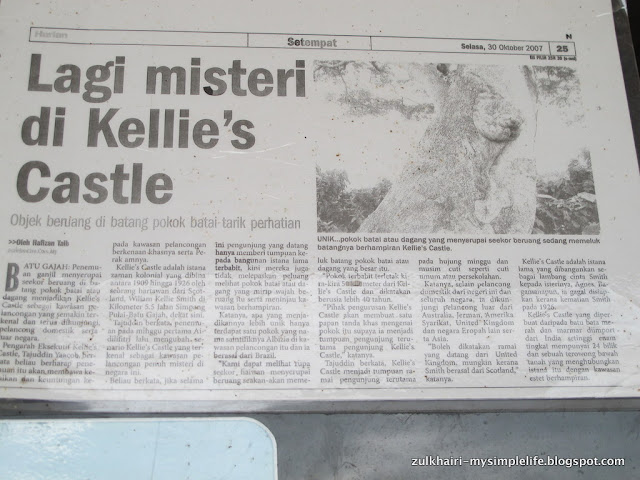 |
| 4th September 2012 morning at Ipoh... Early check-out... |
 |
| early lunch |
 |
| With En. Tajuddin Yaacob. The Director of Aqfast Enterprise, the company who manage the building.. |
Construction Beginning
Because of his fascination with the
Hindu religion and the Indian culture, Smith's plan was for this house to share
similar architecture to those of Madras, with all its bricks and tiles imported
from India. He even employed a big group of Indian labourers to build his dream
house, to keep the Kellas House authentically Indian. The mansion is accessible
from the main road through a bridge running across a stream.
But it was not only the cost of importing
material and labourers from abroad that made the house so fascinating to locals
and travellers alike. Among the many amazing things about Kellie's Castle are an
elevator (it was the first in Malaya) which connects right up to the top floor,
and the existence of two tunnels that run under the river nearby. One of these
tunnels connects to the Hindu temple some distance away from the main house. On
the second floor, Smith planned to build an indoor tennis court — an ambitious
project even by today's standards. On the highest floor, there is a rooftop
courtyard for parties. This castle was to be the hub for entertaining wealthy
colonial planters who had settled in Malaya. His house was so unique that it was
even mentioned in the London Financier newspaper on 15 September 1911
Construction difficulties and Smith's death
Unfortunately for Smith, tragedies struck soon after the construction of the Kellas House began. A virulent strain of the Spanish flu spread from Europe to soon after World War I ended in Europe, killing many of the workers in the Kellas Estate. Another seventy workers constructing Smith's dream castle also became victims of the flu. Smith, who had already spent a fortune on his house, lost a lot of money because of this.
In the end, Kellas House, later known as Kellie's Castle or even Kellie's Folly to some, was never completed. William Kellie Smith himself died of pneumonia during a short trip to Portugal in 1926. His heartbroken wife decided to pack up and return home to Scotland selling the estate and Kellie's Castle to a British company called Harrisons and Crosfield.
Today.......
All these years faded into memory, the castle has been reconditioned to serve as a visitor spot and enjoy the scenery and breeze at the rooftop.Descendants of the Tamil labourers brought over to Malaya to work on the mansion still live nearby even now. Kellie's Castle is now a popular local tourist attraction and was used as a setting in the 1999 film Anna and the King.
The Myths...
There have been many myths or legends or rumors spreading around about the mysterious castle. Some say that the Smith's spirit still wandering inside the castle, especially along the corridors, guarding his great mansion. And that's why much of the structure still intact after so many years.
Some say there are lots of "spirits" wandering around the castle since workers died during the construction and people died during the 2nd world war. It is believed that there are 4 underground tunnels. One is connecting the Kellies Castle to the Hindu temple 500m in the west, one is connecting to the main gate garage in the south and one is connecting to the road in the east.
How about the last one? It's still undiscovered. There are rumors about this secret tunnel had been used as an execution hub of the Japanese army in World War II. And some say it was the secret tunnel being used by Chen Ping (the famous communist leader in Malaya) in between 50s to 60s. Some say the Smith's car is parked in one of the tunnels.



.jpg) |
| Film production at the building.. TQVM to En. Tajuddin for the photos... |
 |
| Actors with costume |
 |
| Paip Besar or Giant Pipe or Huge Pipe at Gopeng situated approximately 20 km south of Ipoh. |












































Thanks for sharing such a nice information with us. Please keep on posting so that I can keep myself updated.
ReplyDeleteTitle Insurance miami
Cool..any rumors about the tree with the bear head?
ReplyDelete